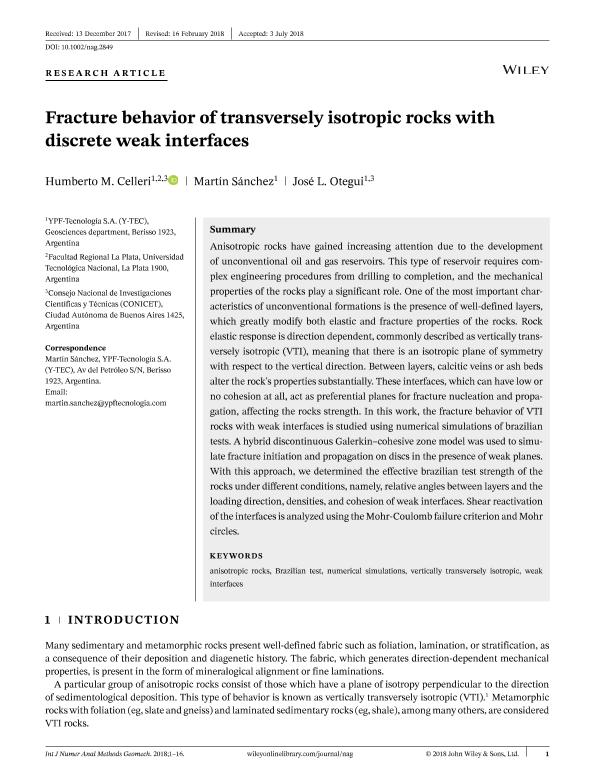Mostrar el registro sencillo del ítem
dc.contributor.author
Celleri, Humberto Mauro

dc.contributor.author
Sanchez, Martin

dc.contributor.author
Otegui, Luis Jose

dc.date.available
2020-02-03T13:52:07Z
dc.date.issued
2018-12
dc.identifier.citation
Celleri, Humberto Mauro; Sanchez, Martin; Otegui, Luis Jose; Fracture behavior of transversely isotropic rocks with discrete weak interfaces; John Wiley & Sons Ltd; International Journal For Numerical And Analytical Methods In Geomechanics; 42; 18; 12-2018; 2161-2176
dc.identifier.issn
0363-9061
dc.identifier.uri
http://hdl.handle.net/11336/96511
dc.description.abstract
Anisotropic rocks have gained increasing attention due to the development of unconventional oil and gas reservoirs. This type of reservoir requires complex engineering procedures from drilling to completion, and the mechanical properties of the rocks play a significant role. One of the most important characteristics of unconventional formations is the presence of well‐defined layers, which greatly modify both elastic and fracture properties of the rocks. Rock elastic response is direction dependent, commonly described as vertically transversely isotropic (VTI), meaning that there is an isotropic plane of symmetry with respect to the vertical direction. Between layers, calcitic veins or ash beds alter the rock's properties substantially. These interfaces, which can have low or no cohesion at all, act as preferential planes for fracture nucleation and propagation, affecting the rocks strength. In this work, the fracture behavior of VTI rocks with weak interfaces is studied using numerical simulations of brazilian tests. A hybrid discontinuous Galerkin–cohesive zone model was used to simulate fracture initiation and propagation on discs in the presence of weak planes. With this approach, we determined the effective brazilian test strength of the rocks under different conditions, namely, relative angles between layers and the loading direction, densities, and cohesion of weak interfaces. Shear reactivation of the interfaces is analyzed using the Mohr‐Coulomb failure criterion and Mohr circles.
dc.format
application/pdf
dc.language.iso
eng
dc.publisher
John Wiley & Sons Ltd

dc.rights
info:eu-repo/semantics/openAccess
dc.rights.uri
https://creativecommons.org/licenses/by-nc-sa/2.5/ar/
dc.subject
ANISOTROPIC ROCKS
dc.subject
BRAZILIAN TEST
dc.subject
NUMERICAL SIMULATIONS
dc.subject
VERTICALLY TRANSVERSELY ISOTROPIC
dc.subject
WEAK INTERFACES
dc.subject.classification
Otras Ciencias Naturales y Exactas

dc.subject.classification
Otras Ciencias Naturales y Exactas

dc.subject.classification
CIENCIAS NATURALES Y EXACTAS

dc.title
Fracture behavior of transversely isotropic rocks with discrete weak interfaces
dc.type
info:eu-repo/semantics/article
dc.type
info:ar-repo/semantics/artículo
dc.type
info:eu-repo/semantics/publishedVersion
dc.date.updated
2019-10-11T13:48:35Z
dc.journal.volume
42
dc.journal.number
18
dc.journal.pagination
2161-2176
dc.journal.pais
Reino Unido

dc.journal.ciudad
Londres
dc.description.fil
Fil: Celleri, Humberto Mauro. Universidad Tecnológica Nacional; Argentina. Consejo Nacional de Investigaciones Científicas y Técnicas; Argentina. YPF - Tecnología; Argentina
dc.description.fil
Fil: Sanchez, Martin. YPF - Tecnología; Argentina
dc.description.fil
Fil: Otegui, Luis Jose. YPF - Tecnología; Argentina. Consejo Nacional de Investigaciones Científicas y Técnicas; Argentina
dc.journal.title
International Journal For Numerical And Analytical Methods In Geomechanics

dc.relation.alternativeid
info:eu-repo/semantics/altIdentifier/url/https://onlinelibrary.wiley.com/doi/abs/10.1002/nag.2849
dc.relation.alternativeid
info:eu-repo/semantics/altIdentifier/doi/http://dx.doi.org/10.1002/nag.2849
Archivos asociados
